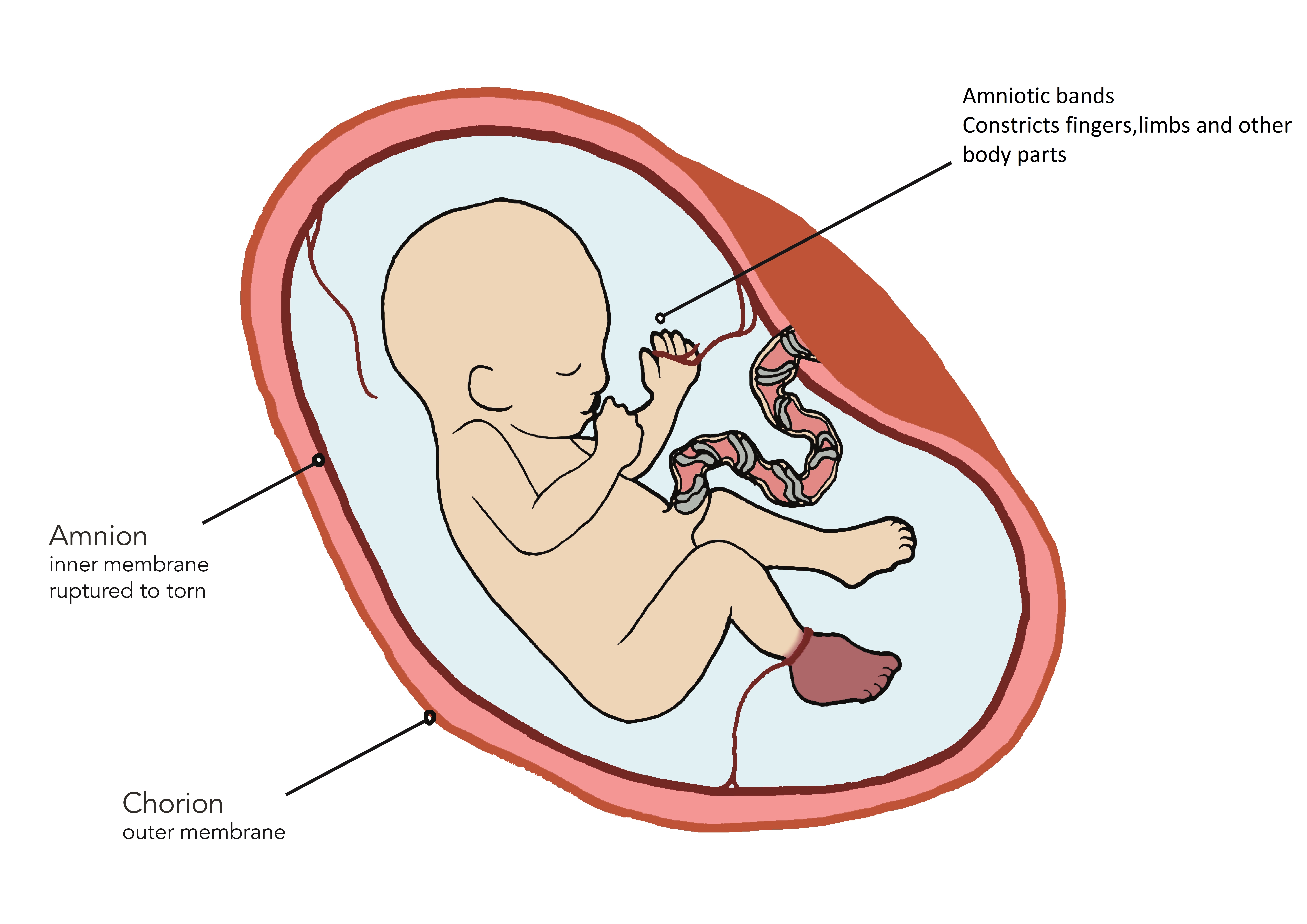Amniotic Band Syndrome
Amniotic Band Syndrome
What is amniotic band syndrome?
Amniotic band syndrome is a rare condition caused by strands of the amniotic sac that separate and entangle digits, limbs, or other parts of the fetus. This constriction can cause a variety of problems depending on where strands are located and how tightly they are wrapped.
The developing fetus floats in amniotic fluid in the mother’s uterus. What keeps the fluid around the fetus and in the uterus is a sac. This sac has 2 layers which are stuck together: the outermost layer which lines the uterus is called the “chorion”, and the layer closer to the fetus is called the “amnion”.

It is believed that amniotic band syndrome occurs when the inner membrane (amnion) ruptures, or tears, without injury to the outer membrane (chorion). The developing fetus is still floating in fluid but is then exposed to the floating tissue (bands) from the ruptured amnion. This floating tissue can become entangled around the fetus.
The incidence of amniotic band syndrome is 1 in 1200 to 1 to 15,000 live births. The cause of amnion tearing is uncertain and is consider a chance event. It does not appear to be genetic or hereditary, so the likelihood of it occurring in another pregnancy is not common.
What is the outcome for a fetus with amniotic band syndrome?
The complications from the amniotic band syndrome can range from mild to severe. In mild cases, a band may become wrapped around digits (fingers or toes) of the fetus. This can result in amputations of the fingers or toes, or syndactyly of the fingers or toes. Syndactyly is a condition where the fingers or toes become fused together, or webbed, which can be treated surgically after birth. Amniotic bands attached to the face or neck can sometimes cause deformities such as cleft lip and palate.
In other instances, a band can be wrapped around a limb (arm or leg) resulting in restriction of movement leading to deformities such as clubbed foot. In more severe cases, an amniotic band can become tightly wound around a limb leading to decreased blood supply and resulting in possible amputation of the limb.
The most severe, and life-threatening complication of amniotic band syndrome is if a band becomes wrapped around vital areas such as the head or umbilical cord. Constriction to the umbilical cord or other vital areas can result in fetal death.
How serious is my fetus’s amniotic band syndrome?
Each case is unique, multiple strands may be entangled around the fetus, and the severity can range from mild to life-threatening depending on where the bands are constricting and how tightly they are wound.
If there is evidence of amniotic bands, a detailed ultrasound test should be done to assess the severity and avoid a misdiagnosis. Amniotic bands can be difficult to detect by ultrasound because of their small size, so it is important to have your case reviewed by someone knowledgeable in amniotic band syndrome. The individual strands are often hard to see on an ultrasound, and typically the condition is detected indirectly by the constrictions and swelling they cause to limbs and other parts of the fetal body.
What are my choices during this pregnancy?
Amniotic band syndrome causes no increased risk for the mother during pregnancy. Most complications of amniotic bands are handled after birth. For more severe cases, a detailed assessment of your situation is necessary before fetal surgery can be considered as an option.
In cases where the situation is mild, fetal surgery is not recommended and any complications will be treated after birth by reconstructive surgery. All cases of amniotic band syndrome should be monitored by ultrasound during pregnancy for potential increasing severity.
More severe cases may be considered for fetal surgery provided the maternal and fetal risks of surgery are small. A full evaluation is required before going ahead with fetal surgery as each case of amniotic band syndrome is unique and additional complications may be present. Fetal surgery may be a treatment option in select cases. This can be offered when the band is around a limb and causing swelling and obstructing blood flow to the limb. The fetal surgeons can enter the uterus with a small instrument and attempt to cut the band around the limb. This can be accomplished by either disrupting the band with a laser or cutting the band with a sharp instrument. In a retrospective study by Dr. Lee and colleagues (Fetal Diagn Ther 2015), our experience with this procedure was reviewed. Overall survival was 74% and outcomes were improved when there was no cord involvement.
What will happen after birth?
A fetus with amniotic bands syndrome may require treatment after birth. Occasionally reconstructive surgery might be needed to correct deep constriction grooves, fused fingers or toes, cleft lip, or clubbed feet. Your child’s surgical needs will range from minor to complicated depending on the extent of the deformities caused by the amniotic bands.
